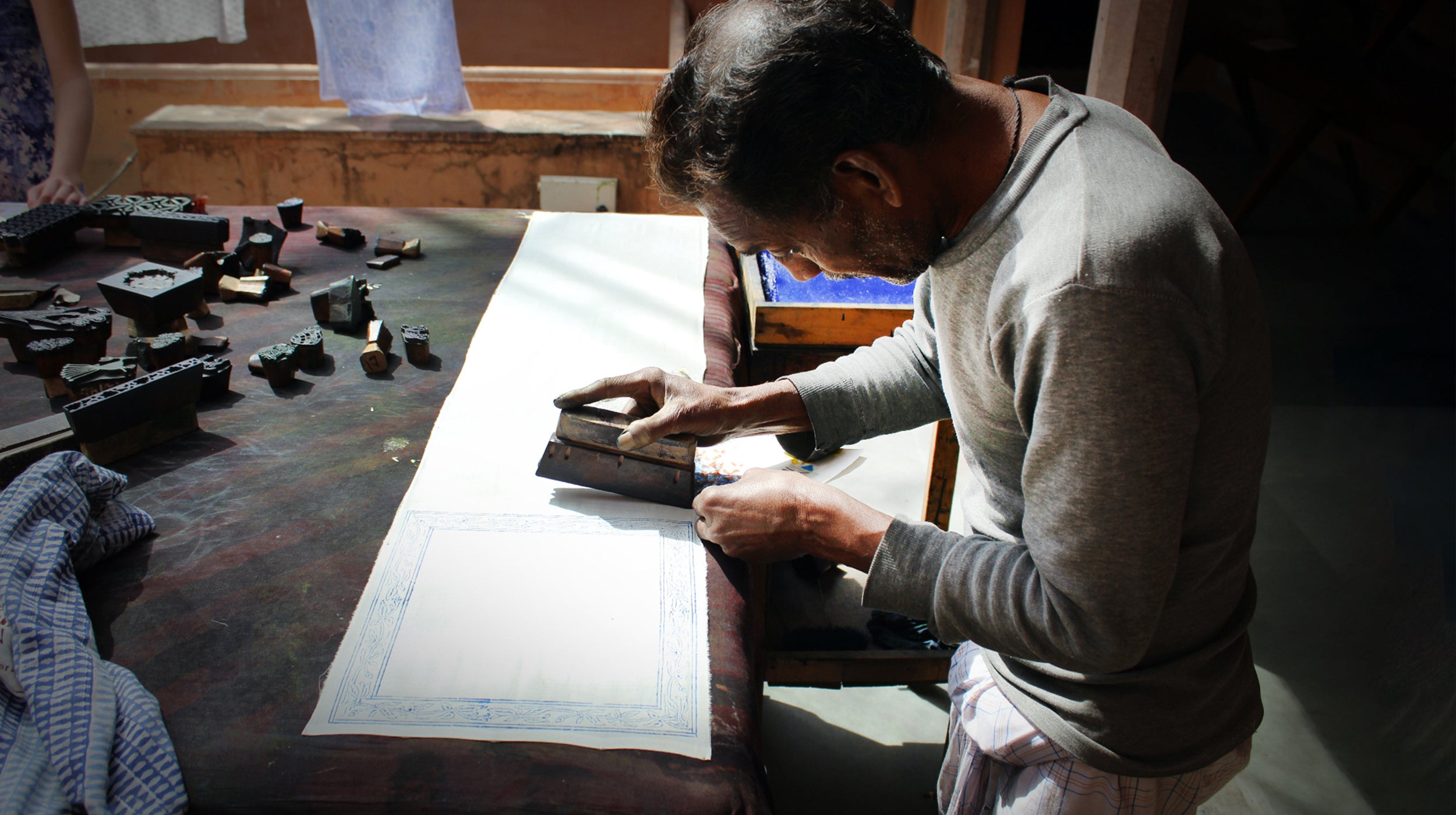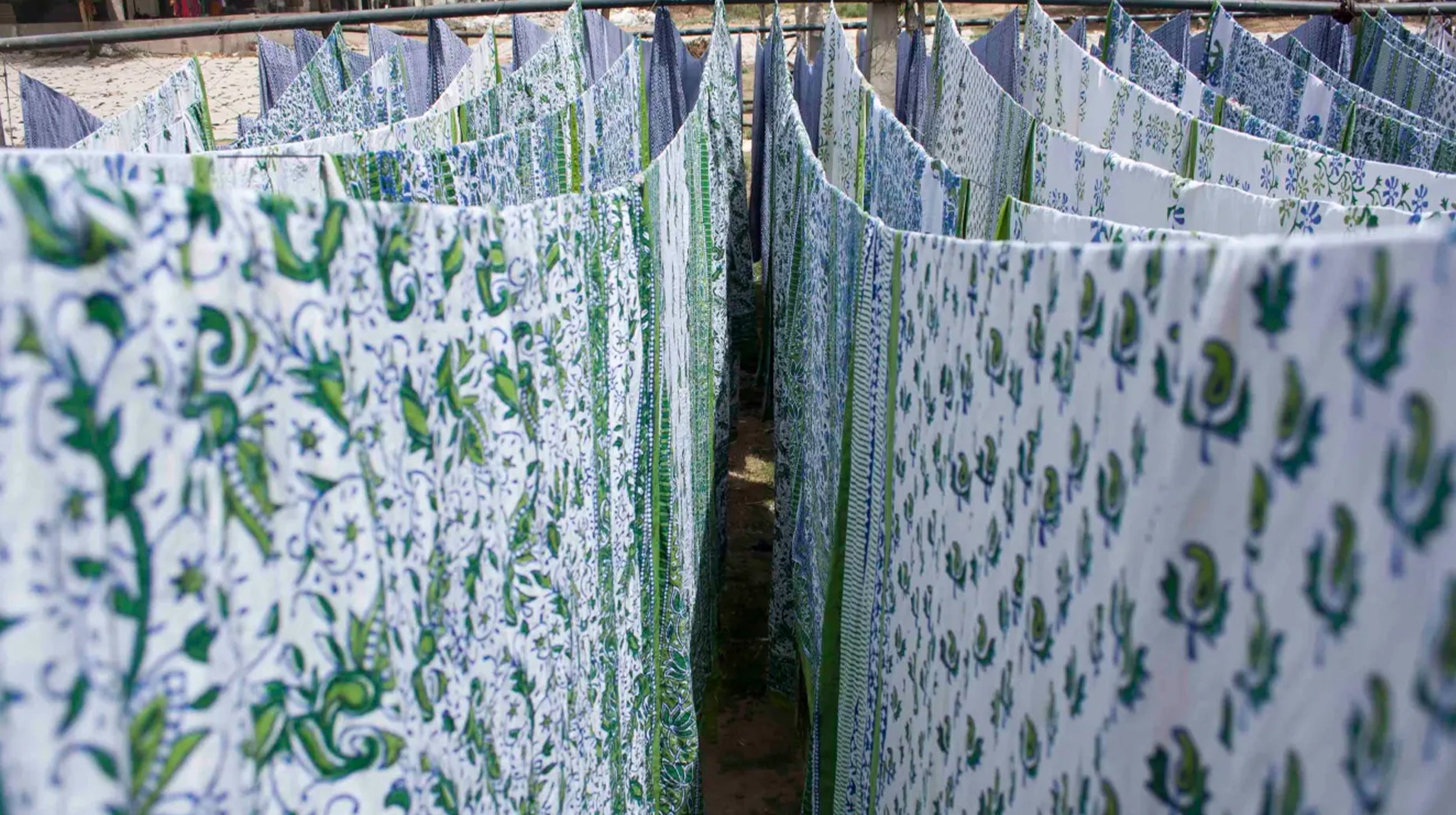Indigo- From Natural Dyes to Shades of Blue
Indigo hand-block prints, first uncovered in the 18th century, have consistently retained their popularity and fashion appeal over the years. This age-old method of crafting indigo-printed textiles continues to be a fundamental aspect of Indian Ethnic wear.
Textile manufacturers in India are scarce when it comes to dedicating time to process natural indigo and create block-print fabrics. Yet, there exists a region in the country where both of these processes persist and flourish. In the cultural hub of Rajasthan, a region distinguished by its commitment to preserving traditional practices, you'll discover craftsman dedicated to the meticulous processing of natural indigo and the crafting of block-print fabrics. Here, time-tested techniques are employed to create intricate handcrafted indigo block prints. These artistic prints are skillfully transferred onto fabrics, giving rise to stunning ethnic wear designed for both women and men.
India has played a leading role in the practice of dyeing and printing with natural colors. Historically, the method of dyeing with indigo posed a mystery for many travelers to India, as no color was visible when fabric was submerged in indigo baths; the hue would only manifest upon exposure to open air.
Use of Indigo Vat
Indigo baths are a fundamental aspect of the indigo dyeing process, commonly used in textile crafts including indigo prints. In the indigo dyeing technique, the fabric is submerged in a vat containing indigo dye. The fabric is then removed, and upon exposure to air, the indigo oxidizes, transforming from a greenish-yellow to its characteristic deep blue color. This process is repeated multiple times to achieve the desired intensity of color. Indigo baths are not only crucial for imparting color but also contribute to the unique visual appeal associated with indigo prints, showcasing a range of shades from light to dark blue.

The process of Indigo Hand-Block Printing
The process of crafting indigo block prints commences by immersing bundles of indigo plants to extract the vibrant dye. Simultaneously, long cotton sheets are laid out to absorb the rich color. To create intricate designs, hand-carved wooden blocks are employed to apply a wax resist to the cotton fabric. Once the fabric undergoes the dyeing process, the areas treated with wax retain their original white color, while the rest of the sheet adopts dynamic hues reminiscent of lapis lazuli, cerulean, and midnight—derived from the exotic indigo plant. These block prints are widely favored for various Indian ethnic wear styles such as kurtas, salwar-kameez, skirts, palazzo pants, dupattas, and more.
Step 1: Preparation of Fabric
The fabric, usually cotton or silk, is pre-washed to remove any impurities and to ensure that it is ready to absorb the dye. It is then treated with a mordant, a substance that helps the fabric hold the dye.
Step 2: Crafting of Indigo Dye
Indigo plants are grown and harvested, with their leaves serving as the primary source of dye. After harvesting, the indigo leaves undergo a fermentation process, stacked in containers with water to activate enzymes that convert precursor molecules into a soluble form of indigo. Following fermentation, the liquid is exposed to air, undergoing oxidation and transforming into the insoluble pigment responsible for indigo's characteristic blue color. The indigo solution is then allowed to settle, and impurities are filtered out, resulting in a clear indigo solution. This liquid indigo is subsequently evaporated to form a concentrated paste or cake, facilitating storage and transportation. The final step involves drying the indigo paste or cake, producing a stable and concentrated indigo dye product ready for use.

Step 3: Block Printing
Block printing is a pivotal stage in the indigo hand-block printing process, where the meticulously carved wooden blocks come to life. These blocks, each representing a specific element of the design, are dipped into the indigo dye bath. The skilled artisan then carefully places the block onto the fabric and presses it down evenly. This rhythmic and precise process is repeated across the entire length of the fabric, creating a continuous pattern. The pressure applied during printing ensures that the indigo dye is transferred from the block to the fabric, imprinting the chosen design. The beauty of block printing lies in the artisan's expertise to align the blocks seamlessly, resulting in a cohesive and visually stunning pattern on the fabric. This hands-on method not only imparts a distinctive handmade charm to each piece but also preserves the cultural and traditional essence of indigo hand-block printing.

Step 4: Drying
After the block printing is complete, the fabric is left to dry in the open air. The crucial part of the process occurs as the fabric is exposed to the air. As the indigo molecules come into contact with oxygen, they undergo oxidation and transform back into their insoluble, blue form. For a deeper or more intense color, the fabric may be dipped into the dye bath multiple times, allowing the oxidation process to occur each time. Once the desired color is achieved, the fabric is left to dry. This drying process helps set the indigo color onto the fabric fibers.
Step 5: Repeat Printing (if necessary)
In some cases, multiple rounds of block printing may be required to achieve the desired depth of color and intricate patterns. Each round involves using different blocks and applying additional layers of dye.
Step 6: Washing and Finishing
After the completion of the block-printing and subsequent drying phase, the fabric proceeds through a crucial washing process. This step holds paramount importance as it serves to eliminate any surplus dye and residual mordants or chemicals that might linger on the fabric surface. To ensure thorough cleansing, the fabric is subjected to multiple washing cycles. Following this, a meticulous rinsing procedure is undertaken, executed with precision to remove any lingering soap or washing agents without compromising the intricacies of the printed design.
The journey of the fabric continues with a dedicated effort to enhance its texture and impart a soft feel. This is achieved through a carefully orchestrated softening process, which can encompass the application of fabric softeners or the utilization of natural methods. The fabric, now imbued with a desirable softness, is then left to air dry. This phase is of utmost significance, playing a pivotal role in setting the vibrant colors and preserving the integrity of the intricate printed design.
Once the fabric has thoroughly dried, it may undergo a pressing or ironing process. This step is instrumental in providing the fabric with a smooth finish, thereby elevating the overall appearance of the printed design. Each stage in this post-printing journey is a testament to the meticulous care taken to ensure not only visual appeal but also comfort and durability in the final indigo hand-block printed fabric.
Step 7: Quality Check
The quality check in indigo hand-block printing involves a comprehensive assessment of the fabric to ensure it adheres to specific standards. Skilled artisans or quality control experts initiate this process by visually inspecting the fabric for uniform coloration, clarity of the printed design, and overall aesthetic appeal. Color fastness is tested to confirm that the indigo dye has properly set, preventing color bleeding during subsequent washes.
Attention is given to the alignment and symmetry of the printed design, checking for consistency across the fabric. The fabric's integrity is examined for damages, tears, or defects that may have occurred during printing, washing, or finishing. These meticulous quality checks are pivotal in upholding the standard and durability of indigo hand-block printed textiles, meeting the expectations of both artisans and consumers.
Why Indigo Fabrics Bleed
The bleeding of indigo fabrics is rooted in the unique characteristics of indigo dye. Unlike some other dyes that chemically bond with fabric fibers, indigo relies on a physical adherence process. When the fabric encounters water, especially during the initial washing stages, the indigo particles may release, leading to the characteristic bleeding. This phenomenon, often known as "crocking," is a normal occurrence with indigo-dyed textiles. To mitigate bleeding, it is advisable to wash indigo fabrics separately or with similar colors during the early washes. Over time, as excess dye is gradually removed the bleeding tends to diminish.


